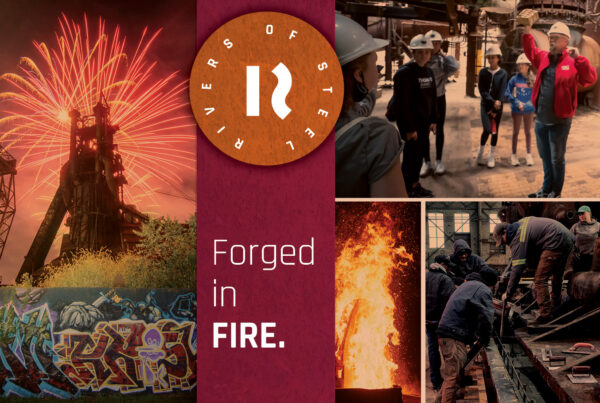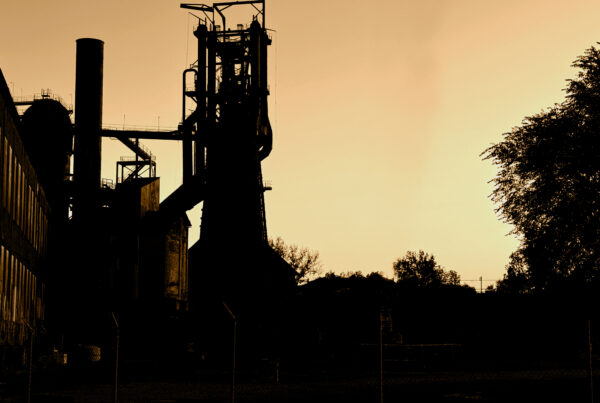
The City of Bridges. All images in this story are courtesy of Jeffrey Bowser, Instagram: fort_frick_412.
A Look at the Society of Architectural Historians’ 2022 Annual International Conference
By Jordan Snowden
As Drew Armstrong is chatting on Zoom about the Society of Architectural Historians (SAH) 2022 Annual International Conference, he’s also looking out his window, which overlooks the Carnegie Library of Pittsburgh’s Main Branch.
“I can actually look right over on the stairs and watch people,” says Armstrong, the Director of Architectural Studies and Associate Professor at the University of Pittsburgh. “I watch how people behave, and it’s amazing what goes by your window. To me, that is a reflection of very specific configurations of what’s around here, where things are located, what makes people comfortable, even where the sun is. You know, if you’re going to sit on the steps, have lunch, or have a conversation. None of that’s about history; although it is—you can see it in many different ways.”

The steps of the Carnegie Library of Pittsburgh.
Armstrong and Sahar Hosseini, an Assistant Professor in the University of Pittsburgh’s History of Art and Architecture department, are the local co-chairs for this year’s SAH conference. They are firm believers that history is what is here; that we are bound to deal with history simply because it’s what’s present. It’s part of why they are so excited to show off the City of Bridges and its diverse landscape with the globe-spanning Society of Architectural Historians members who will be attending the 75th annual conference—the first in-person SAH conference in two years—to share what Pittsburgh’s landscape and architecture tell about the city’s past and its people.
“The way most [architectural historians] think about a building is not frozen in the past,” says Hosseini. “The building’s life starts from the past; it doesn’t end in the past. It continues, and each building has multiple lives. It continues to present and future. The buildings and the landscape and the city are just a way to frame these factors that contribute to making, for example, a landscape.”

The rear of the Produce Terminal in the Strip District with St. Stanislaus Kostka Church. Learn about the Pennsylvania Railroad Fruit and Auction Building and St. Stan’s during one of the public SAH tours.
Together with SAH Conference Chair Patricia Morton, Hosseini and Armstrong planned the 2022 conference tour site locations and a few other events, notably the Saturday seminar that focuses on current issues in the city itself.
“We care about what city [the conference] goes to, and the city itself is a really integral part to what happens during the conference,” says Armstrong.
Taking place from April 27 to May 1, the SAH 2022 Annual International Conference will feature thirty-seven paper sessions, keynote talks, social receptions, a city seminar, and architectural tours in Pittsburgh and nearby areas. Of those events, twenty-seven architectural tours, the Saturday SAH Pittsburgh Seminar, and the Sekler Talk, which architectural and urban historian Itohan Osayimwese will deliver, are open to the public.
“Even if you’re not interested in architectural history, the environment is used to tell a story,” says Hosseini. “So you can come to watch and listen and participate in the story. We’re hoping that we get people from the community to participate and share their thoughts at the Saturday seminar. It’s designed to be in conversation with the city and the community.”
Like Hosseini and Armstrong’s view of history, how the past informs the present, speakers at the Saturday SAH Pittsburgh Seminar will discuss how history informs current initiatives and future visions when considering building in Pittsburgh. Other topics include how a neighborhood, site, or installation can be reimagined as a place of inspiration and how Pittsburghers are working together to confront, challenge, and counter the destabilizing effects of local traumas and global threats.
“Virtually any architectural project in any city, any site, you are compelled—if there’s anything being changed about a building or a landscape—you are compelled to deal with history,” says Armstrong.
Visitors, native Pittsburghers, and Pittsburgh transplants can all find something to appreciate and learn in the various public conference tours. The Allegheny County Courthouse provides a combination of function and artistry. The Smithfield United Church of Christ and the historic ALCOA building allow an opportunity to analyze the application of aluminum. A tour of Pittsburgh’s Northside gives a look into the idea of the city as a place richly layered in time and history. While the Rivers of Steel partnered event, Heritage and Commerce: Redeveloping Pittsburgh’s Brown Sites, shows how sites in Pittsburgh are being creatively reused.
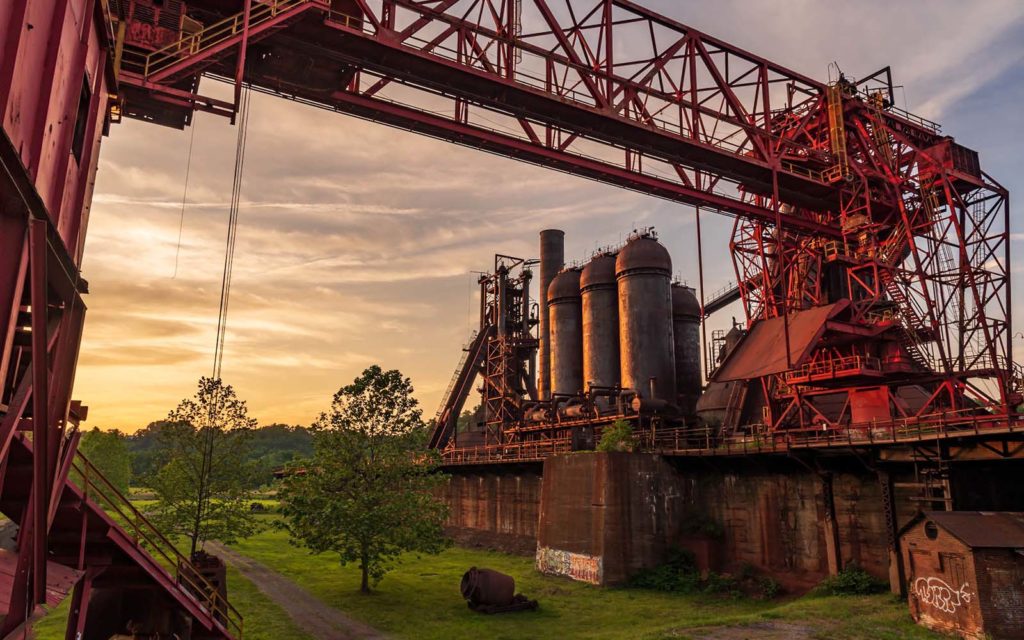
Sunset at the Carrie Blast Furnaces, one of the two sites that are part of the Heritage and Commerce: Redeveloping Pittsburgh’s Brown Sites tour.
Led by Rivers of Steel’s Director of Historic Resources and Facilities, Ron Baraff, alongside GBBN Architects Principal, Anne Chen, the Heritage and Commerce tour will take attendees to Carrie Blast Furnaces, a National Historic Landmark site managed by Rivers of Steel, and Mill 19, a location found in the Pittsburgh neighborhood of Hazelwood. Mill 19 is being redeveloped as a hub for manufacturing research and development within the original steel structure of the former LTV Steel site. Combined, Mill 19 and Carrie Blast Furnaces demonstrate Pittsburgh’s revitalization and the durability of its history of innovation.
“Because of the concrete nature of architecture, it’s an excellent way of showcasing things that have contributed to the making of it,” says Hosseini. “Specifically, I’m thinking about the city of Pittsburgh because of the concrete nature of these buildings and landscapes, like, say, Carrie Furnaces. It talks about a very specific chapter of the city of Pittsburgh, which doesn’t end there. It continues, and that’s the beauty of the site, is that it actually shows it as a living thing. I could talk about it for many hours, but if you go there and see the physicality of it, it’s a much better story, and that makes it all much more appealing.”
If someone were to ask why Hosseini and Armstrong picked the tour spots that they did, when there’s such a wide range of options to choose from when discussing Pittsburgh’s topography, it’s not as simple as saying that they thought certain locations were better than others. The pair believe that all of the sites that people can potentially visit are interesting—it doesn’t have to be Frank Lloyd Wright to make an impact. Hosseini and Armstrong aimed to provide conference attendees with options of various scales, at different times, in multiple parts of the city. Their decisions came down to two key questions: “What is it about a particular site or tour that tells something about the history of Pittsburgh?” and “What story does it tell about Pittsburgh and its history and its people?”
“We also wanted to make sure that we were covering sites that had something new or novel or value that didn’t get covered at the previous conference in Pittsburgh in 2007,” says Armstrong. “We wanted to show people that there’s been development and change.”
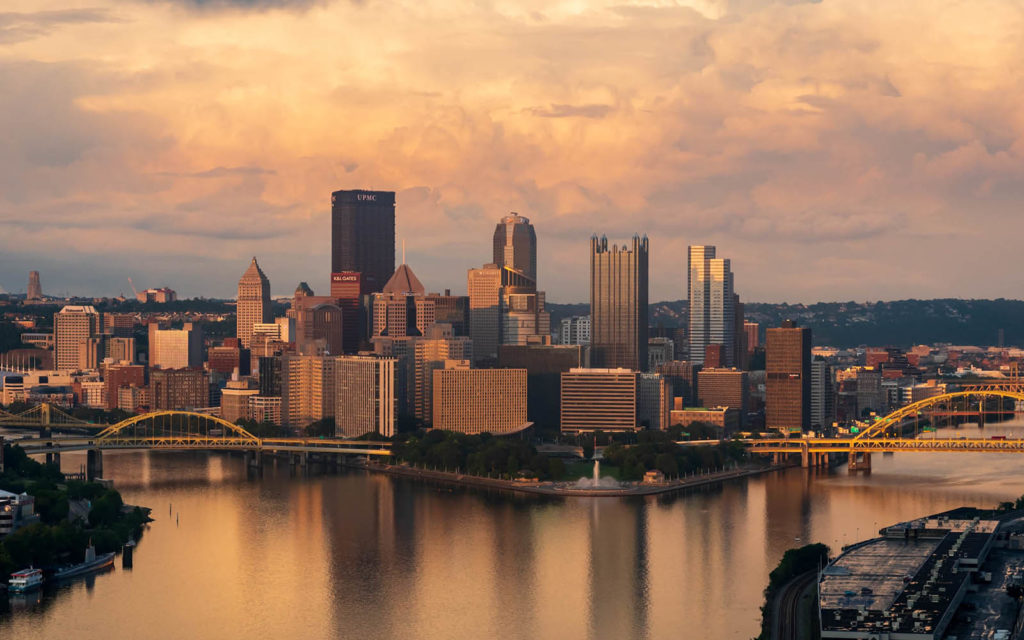
An iconic view of Pittsburgh from the West End.
The Wednesday tour to Mount Washington, for example, was chosen because it’s a rare case of a city where visitors can stand in one position and look over the densest, most central part of Pittsburgh and experience the geography, landscape, topography, and built environment and how those relate to one another.
“Pittsburgh is very much a product of its landscape,” says Hosseini.
Longtime members of SAH, Hosseini and Armstrong are thrilled to have had the chance to contribute to the organization, which has supported Hosseini’s own architectural research in the past. The planning process for the 2022 conference started in early 2020, before the pandemic. While much has changed in the two years since, Hosseini and Armstrong’s enthusiasm for the Society of Architectural Historians, the upcoming conference, and Pittsburgh’s architecture has not waned.
“We’re excited to share Pittsburgh with people who are coming from the outside,” says Hosseini. “This is something that SAH has been very specific about, the cities that it comes to. They want to showcase the city, and they care about the building and environment of the city that hosts the conference.”
 Jordan Snowden is a freelance writer based in Pittsburgh whose work has been published in The Seattle Times, Pittsburgh City Paper ,and elsewhere. She also runs @jord_reads_books, a book-focused Instagram account where she connects with other bookworms. In her free time, Jordan can be found with a book in her hand or DIYing something with her husband.
Jordan Snowden is a freelance writer based in Pittsburgh whose work has been published in The Seattle Times, Pittsburgh City Paper ,and elsewhere. She also runs @jord_reads_books, a book-focused Instagram account where she connects with other bookworms. In her free time, Jordan can be found with a book in her hand or DIYing something with her husband.
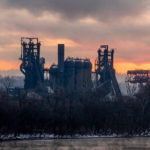 Jeffrey Bowser is a local Pittsburgh photographer. His work focuses on Pittsburgh cityscapes, churches, industrial photography, and the Homestead / Mon Valley area. You can follow him at fort_frick_412 on Instagram and learn more about him and his work here.
Jeffrey Bowser is a local Pittsburgh photographer. His work focuses on Pittsburgh cityscapes, churches, industrial photography, and the Homestead / Mon Valley area. You can follow him at fort_frick_412 on Instagram and learn more about him and his work here.

